
|
||||||||||||||||||||||||||||||||||||||||||||||
Winchester does a great job of capturing the look and feel of a traditional lever action rifle. Obviously a very slick little gun, and flawless coming out of the box, it is still very much a rifle to be found behind the counter of a country store, right along side the sacks of beans and flour, porcelain pots and pans and oil burning lanterns.
The Winchester Trails End Takedown is light, fast handling and powerful. A solid little gun that smells of oiled blued steel and walnut. The 450 Marlin cartridge, loaded with 300 to 350 grain bullets is excellent for deer, hogs and black bear. Loaded up with heavier bullets, up to 500+ grains, it has more than enough power for the largest and most dangerous North American game.
The Winchester is an easy carry because of its lightweight and compact form. I suppose sling swivels could be installed, but the front swivel stud would have to be positioned on the forearm, or at its cap, because the Takedown’s tubular magazine assembly is removed during taken down, which would preclude attaching a banded swivel.
The forearm, unlike most other currently manufactured lever action rifles, is narrow. Like my 1957 Marlin 336, and the original Winchester Model 94, the current forearm is about 1.3″ wide. This keeps rifle weight down and it feels comfortable… steady, when shooting. None of the five current variations of the Model 1894 have pistol grips, which is fine by me. They are not needed on this type of rifle and their absence, again, means less weight.
The Trails End’s barrel, at 20″, is a short barrel within the Model 94 lineup. Both the Cabela’s 50th Anniversary Model and the somewhat period fancy Model 94 Sporter have 24″ barrels. For the 450 Marlin cartridge, the 20″ barrel is a good compromise between performance and convenience, and the missing 4″ is worth about a pound in rifle weight compared to the longer 24″ barrel versions.
The length of pull on the Trails End is about right, with an inch of that length attributed to the welcome presence of a Decelerator recoil pad. Comb and heel height are optimal for metallic sights.
If you can’t hit with these, you really need to practice…
I read, somewhere on the Internet, that these sights are imprecise, unusable and should be replaced with a scope. That would probably come as quite a shock to the literally millions of folks who have hunted, shot competitively and served a military hitch in combat assignments with pretty much the same combination of notched rear sight and ramped bead front sight. Yes, the little notch nestled between the buckhorns is tiny, which is what allows a shooter to pin point a spot on a target.
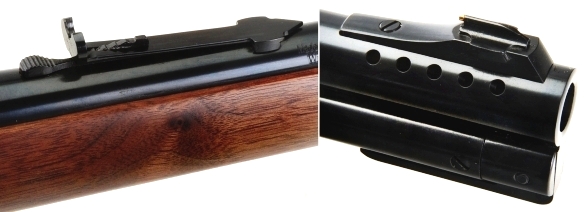
While distance between front and rear sight ultimately determines the degree of change in elevation for each of the steps on the rear sight elevator, it is approximately 1 MOA @ 100 yards per step. Windage is adjusted by drifting the rear sight. A 4 ounce hammer tap on a brass or nylon drift = 1/4 MOA, and 8 ounce hammer yields 1/2 MOA shift and a 16 ounce hammer tap will produce a 1 MOA offset. No, I am not being serious. My point is that you look at the external trajectory of the ammo you want to use for hunting or recreational target shooting, take your rifle to the range and click and tap away on the rear sight until you have the desired zero.
What about when you change to ammo that shoots to a different point of impact? You adjust your sights, as you would with a scope or peep sight, or you get familiar with your rifle until you know how much to compensate for a specific load when juggling ammunition. Don’t want to spend that much time learning your Model 94’s shooting characteristics? Mount a scope or a receiver or tang peep sight…. or a red dot. Below, left, two mount holes required for a tang mounted peep sight are visible aft of the slide safety.

In 1992, the Model 1894 was given a cross bolt safety. The cross bolt safety was retained through 2002, when the Model 1894 was given a hammer blocking sliding tang safety, as pictured, left. The Model 1894 also has a rebounding hammer that replaces the original Model 1894’s full and half cock hammer.
The early style hammer was fired from the full cock position and… sort of safe with a round in the chamber and the hammer lowered to half cock. In this half cock position, theoretically, pulling the trigger would not drop the hammer and fire a round. However, a rifle with worn parts, taking a sharp blow, might drop the hammer from full or half cock.
The current hammer is a rebound hammer where, when dropped from the pull cocked position with the safety in the “off” position, the hammer will momentarily travel full down against the firing pin and discharge the rifle, then return to the rebounded position. With the safety in the “On” position, the hammer is blocked so, even if in the full cocked position, pulling the trigger will still drop the hammer, but the safety will stop the hammer at the rebound position and prevent the hammer from striking the firing pin and discharging the rifle.
The Trails End 450 Marlin has two rows of ports, five holes on each side, 90º of separation. I can say that the muzzle tends to lay flat when shooting. However, not having an unported version of the same on hand, I can’t comment as to how effective the ports are in recoil reduction. For a big round, recoil is very manageable, less severe than a Marlin Guide Gun loaded with hyper 45-70 loads.
A little more than six of one, half dozen of a nuter…
Even though the first chambers available in the Winchester Model 1894 were black powder, .32-40 and 38-55, the rifle was the first Winchester design for smokeless powder. In 1895, .25-35 WCF and .30-30 WCF chambers were catalogued.
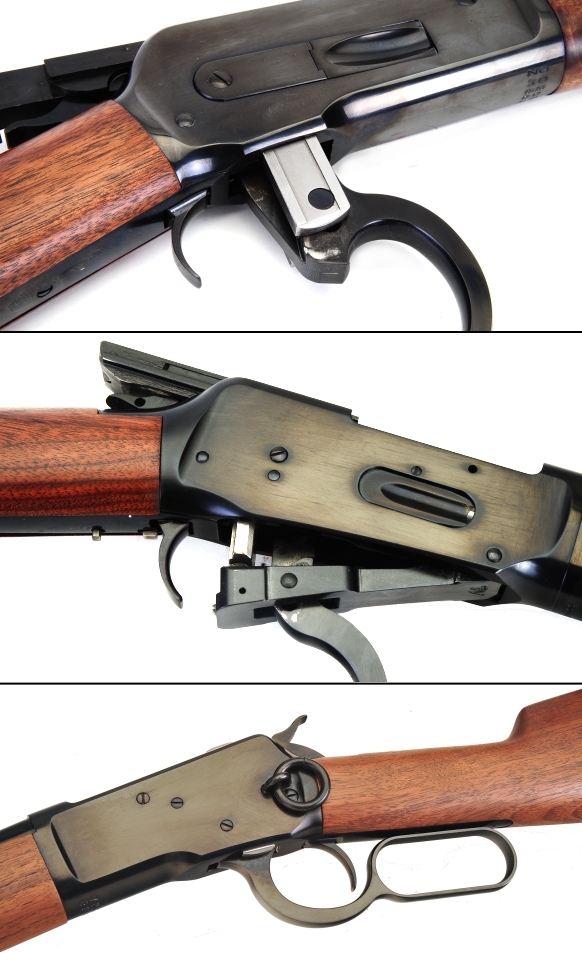
Sandwiched between the Model 1886, top, and the Model 1892, bottom, the Model 1894 does not use Winchester’s vertical locking system design. By hinging the bottom of the receiver at the front, and locating the locking bolt aft, these changes allows for a long cartridge to be chambered in a relatively short and compact lever action. The Model 1894 retains the horizontal bolt rails of the other models, which makes for smooth operation and a lot of strength when the breech is closed.
Takedown is easy
The take down feature is handy. Anyone shipping a firearm to a hunting destination might want to ship the rifle taken down to make it a smaller and less obvious item. Backpacking to a camp where hunting isn’t on the hike agenda, the takedown feature makes the Model 94 easier to transport. Take down is handy for cleaning and makes for a more thorough job.
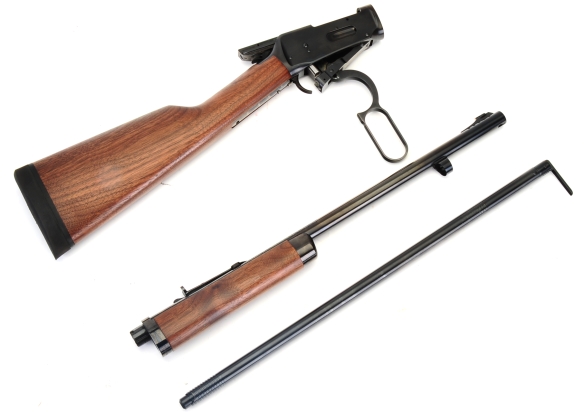
The magazine lever that is affixed to the front magazine plug is extended, and the magazine tube is unscrewed from the receiver. From behind the rifle, with the barrel pointing forward, the rifle’s lever is fully opened. Then the forearm is grasped and rotated clockwise 1/4 turn and pulled free of the receiver. Reassembly is the opposite and as easy.
A whole lot of… thump
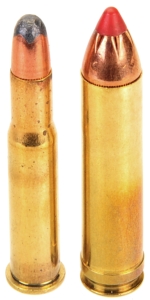
The Winchester Model 1894 Trails End Takedown is available in two chambers, the 30-30 WCF and the 450 Marlin. Other Model 1894 models are also available in 38-55 WCF. The 30-30 WCF is no slouch. I’ve put through and through holes in hefty feral hogs with factory 150 grain loads and I have not had a deer walk away from the same either. I’ve no experience with the 38-55 WCF. The ballistics look good for a lever action round, but I will withhold further comment. I have not hunted with the 450 Marlin, I have hunted quite a bit with the 45-70 Gov’t and would not hesitate, with appropriate loads, to hunt anything in North America.
|
Cartridge |
Bullet Weight |
MV FPS |
ME Ft/Lbs |
| 30-30 WCF | 170 | 2200 | 1827 |
| 38-55 WCF – SAAMI | 255 | 1320 | 987 |
| 38-55 WCF – High Pressure* | 255 | 1950 | 2044 |
| 45-70 Gov’t -SAAMI | 405 | 1330 | 1590 |
| 45-70 Gov’t – High Pressure* | 405 | 2000 | 3597 |
| 450 Marlin | 405 | 1975 | 3507 |
|
* Factory high pressure ammo for use in modern firearms. |
|||
Winchester chambers their Model 1886 long action lever gun in the 45-70, however, not in 450 Marlin. The Model 1894 is just the reverse. Purely conjecture on my part but, because Winchester chambers the 45-70 Gov’t in one firearm, I’d guess concerns over modern ammunition is not the limiting factor with the Model 1894 as the 45-70 Gov’t high pressure loads are essentially internal and external ballistic twins.
The selection of one 0.458″ round over the other may a matter of mechanical design as the interior of the Model 1894 is slightly more narrow, and the stroke shorter, than the Model 1886. The 45-70 Gov’t and 450 Marlin have the same spec for cartridge overall length. The body of the 45-70 Gov’t is 0.506″ in comparison to the 450 Marlin at 0.513″. All still relatively close, however, the .45-70 Gov’t rim is 0.608″, while the rim and belt on the 450 Marlin is only 0.532″, which is about maximum for the Model 1894’s bolt face.
And therefore, and henceforth…
OK, a lot of words… almost put myself to sleep. This progeny of John Moses Browning’s creative genius has been preserved by Winchester Repeating Arms in the form of this well made and attractive firearm. Too slick to be labeled a junk yard dog, but not lacking enough power.
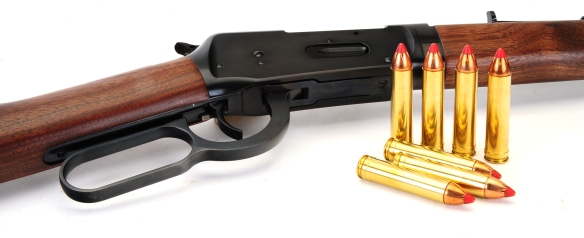
What’s next? Well, I don’t care for the images appearing with this article, so we’ll do a reshoot for Part 2 and for the Real Guns Image Archive. On a preliminary basis, Hornady LeverEvolution 325 grain FTX loads posted 2107 fps over a chronograph against a Hornady rating of 2225 fps. 118 fps difference is relatively negligible considering the Hornady rating is based on a 24″ unported barrel and the Winchester is sporting a 20″ ported barrel. Accuracy was… bolt action like. We’ll be back with Part 2, shortly.
Winchester’s Model 94 Trails End Takedown Part 1
Winchester’s Model 94 Trails End Takedown Part 2

Email Notification